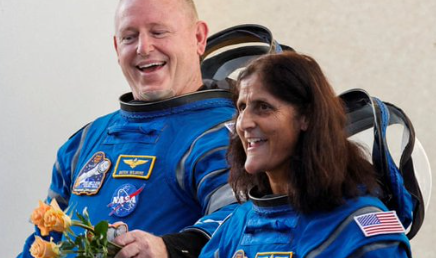This is the hope of NASA, but many are doubting the time table. Perhaps this will take Elon Musk to come to the rescue? Just a thought…
The two NASA astronauts aboard Boeing’s Starliner spacecraft are expected to return by July 20, marking 45 days since their launch on June 5. Starliner is capable of remaining docked to the International Space Station (ISS) for up to 45 days. Initially, astronauts Suni Williams and Butch Wilmore were scheduled to stay for a week, but their return has been delayed multiple times due to helium leaks and thruster issues.
Makena Young, a fellow with the Aerospace Security Project at the Center for Strategic and International Studies, highlighted the challenges of operating in space, especially with human-rated spacecraft developed by commercial companies. “It’s a really hard operating environment when things go wrong,” Young said, noting the difficulty of making repairs in space.
An eight-day trip to space has gone wrong. Two astronauts are stuck indefinitely
Boeing and NASA warned that because this was a test flight to and from the International Space Station, everything might not go perfectly. It hasn’t gone perfectly.#Boeinghttps://t.co/5ARxeo3Xaw
— Rum Corp Rules (@CourtRum) June 26, 2024
Although NASA and Boeing did not immediately respond to inquiries, Boeing assured Newsweek that most of the helium leaks and thruster issues have been resolved and are not a concern for Starliner’s safe return. Currently, only one of Starliner’s 27 thrusters remains offline, while four of the five previously shut-down thrusters are now functioning normally.
An official return date has not been set, but Reuters cited a NASA source indicating a potential return on July 6. Steve Stich, manager of NASA’s Commercial Crew Program (CCP), stated that the team is methodically following their mission management process, ensuring Starliner’s performance in orbit and the astronauts’ safe return.
The mission holds significant importance as Boeing and SpaceX are crucial to NASA’s CCP, which aims to reduce reliance on Russia for transporting astronauts and cargo to the ISS. Since retiring the space shuttle in 2011, NASA has paid nearly $2 billion to Russia to transport 30 astronauts. Turning to private U.S. companies like Boeing and SpaceX is a strategic move to avoid these costs and depend on domestic resources.
So the #Boeing #Starliner astronauts are stuck in space
This is the second private flight mission recently that’s had major issues
Also reason why @NASA has been leaning on @SpaceX, not @boeing or @blueorigin https://t.co/QszB3if6lz
— Oz For NY (Ozsultan.eth) (@OzForNY) June 26, 2024
This mission marks Boeing’s first human transport to the ISS, while SpaceX’s Dragon craft has successfully completed several missions. The delays in Boeing’s mission, although seemingly detrimental, are necessary to ensure the spacecraft’s readiness for human transport. “These setbacks seem like an awful thing… but you desire to make sure that there are no concerns in the back of your mind when you’re saying, ‘OK, yes, this is ready to launch human beings,’” Young stated.
Starliner can operate on backup power for an additional 72 days if necessary. In a critical emergency, SpaceX could launch a rescue mission in collaboration with NASA. Young assured that the astronauts are not stranded, thanks to NASA’s policy of maintaining redundancy. “That’s why NASA always has a redundancy, so that if something does go wrong with one program, the other is able to easily step in.”
Astronauts from Boeing’s Starliner were supposed to be in space for 8 days. Now they’re stuck there with no scheduled return date. #Boeing #Spacestation #InternationalSpaceStation #SpaceX #NASAhttps://t.co/mJ7cjMOFVx
— Mr Robin W. (@robinwiddr7517) June 26, 2024
Safety is of the highest concern, so the wait is understandable to all. No one wants to risk the lives of the astronauts.
Key Points:
i. NASA astronauts Suni Williams and Butch Wilmore, aboard Boeing’s Starliner spacecraft, are expected to return to Earth by July 20 after a series of delays caused by helium leaks and thruster issues.
ii. Starliner, which launched on June 5, can remain docked to the ISS for up to 45 days, and the return date has been tentatively set for July 6, although it has not been officially confirmed.
iii. Boeing has resolved most of the helium leaks and thruster problems, with only one thruster still offline and the others functioning normally.
iv. This mission is Boeing’s first human transport to the ISS, highlighting the importance of having multiple reliable options for space travel and reducing NASA’s reliance on Russia for transporting astronauts.
v. If an emergency arises, SpaceX could launch a rescue mission, underscoring NASA’s strategy of maintaining redundancy to ensure the safety of astronauts and the success of space missions.
RM Tomi – Reprinted with permission of Whatfinger News



